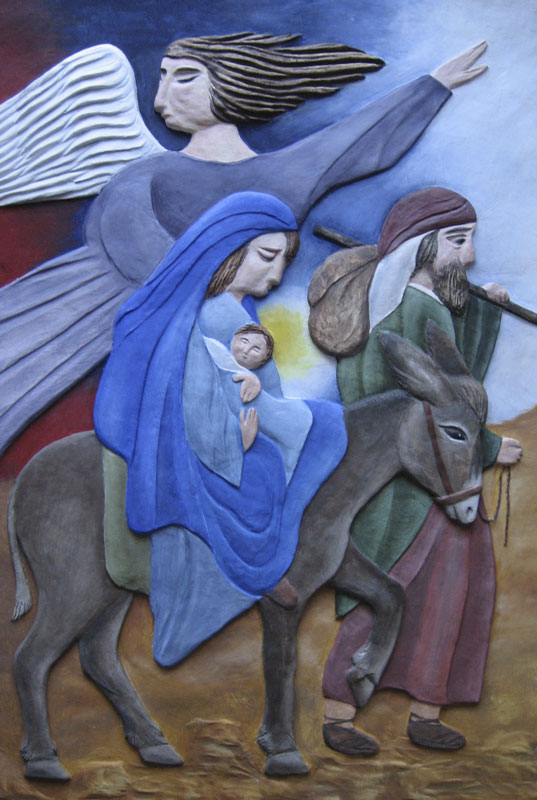Refugees
Notes about the image (in English and German)

Relief, clay with oil
Bernd Hildebrandt 2010
Refugees
At Christmas we celebrate what is expressed in the Nicene Creed: “Very God of very God; … who for us men and for our salvation came down… and was made man”. “Was made man” in every way that human life entails and what is already exemplified in a verse, only to be found in Matthew’s Gospel 2.13: “...behold, an angel of the Lord appeared to Joseph in a dream and said, ‘Rise, take the child and his mother, and flee to Egypt, and remain there till I tell you; for Herod is about to search for the child to destroy him’.”
Theology has not much to say about this very short reference, but the “Flight into Egypt” was soon taken up by legends. Of this the famous Christ Legends of more recent times by Selma Lagerlöf give a good example:
“By the drought and the storm!” said the palm, calling upon life’s most dangerous enemies. “What is that that the women carries on her arm? I believe these fools also bring a child with them! … I understand now: these people are runaways. But they are fools… unless an angel protects them, they would have done better to let their enemies do their worst, than to venture into this wilderness …”
The flight into Egypt became also a favourite subject in paintings of the great masters in the 14th to 16th centuries. The depictions are often of a romanticised nature, especially the pictures of “Rest during the flight”.
But we cannot forget over all this what being a refugee really means, because at any given time millions of people experience the true meaning of such a fate. And Jesus had not been spared any of it.
In my sculpture in clay relief I have reproduced in form and colour what is already familiar to us. But in symbolism, colour can at times represent the opposite to its positive meaning. For instance “red”, the colour of love, of God himself, in his power and in his grace, can also stand for something negative, Satan and hell. And this is the case in my design, where on the left side red and an overall darkness stands for the cruelty, the pain and death, from which the Christ child has escaped. Jesus, at least for the time being, is on his way into light and life.
There is however one important part in the experience of refugees not even mentioned in Matthew’s report, and that is the refuge at the end of the journey, an open door, and compassionate and helpful people. That is a continuing obligation for every generation, every nation and every individual person.
When we celebrate God’s “good will towards men” (Luke 2.14), how can we do other than follow Spurgeon’s advice in a sermon on this, the angels first Christmas Carol: “Do not try to keep Christmas without keeping good will towards men”.
Bernd Hildebrandt, Christmas 2010
Flüchtlinge
Wenn wir Weihnachten feiern, im Glauben begründet, dass Gott für uns in Jesus wahrer Mensch wurde, dann wird dies im knappen Bericht von der Flucht nach Ägypten (Matthäus 2, 13-14) exemplarisch geschildert.
Zu jeder gegebenen Zeit sind Millionen von Menschen in einer Fluchtsituation. Darüber braucht man uns nicht zu belehren. Jesus war einer von ihnen, ganz Mensch in einer all zu bekannten menschlichen Notsituation.
Schon früh ist die Flucht nach Ägypten Thema von phantasievoll ausgeschmückten Legenden geworden. In zahlreichen bildlichen Darstellungen der Meister des 14. bis 16. Jahrhunderts finden wir oft geradezu romantische Züge, besonders in idyllischen Bildern der Ruhe auf der Flucht.
Geborgen in den Armen der Mutter auf einem königlichen Reittier, geführt von einem fürsorglichen Vater, und ganz unter dem Schutz Gottes, darüber kann man die ursprüngliche Bedrohung und vor allem das Schicksal der Zurückgebliebenen fast vergessen. Das ist unbeabsichtigt, aber schwer zu vermeiden.
Ein geradezu klassisches Beispiel fand ich vor Jahren in einem mittelalterlichen Holzschnitt zur Flucht nach Ägypten. Vor den Toren einer Stadt - mit Kirchturm im Hintergrund - geht eine Familie wie auf einem Sonntagsspaziergang. Das kleine Kind trägt ein Körbchen mit Blumen. Was würde man sagen, wenn ich diese Szene hier ins Bild gesetzt hätte? Und doch hat der unbekannte Meister das Thema nicht verfehlt. Er denkt weit voraus und die Menschen seiner Zeit konnten das auch im Bild lesen: Die Blumen im Korb sind Nelken, von alters her “Nägelein” genannt, weil Blätter und Früchte die Form von Nägeln haben. Das Kind trägt somit die Nägel seines Kreuzestodes bereits mit sich.
Meine Darstellung im bemalten Ton-Relief bewegt sich in Form und Farbe im von alters her überlieferten Stil. In der Symbolik haben Farben oft neben der positiven Bedeutung auch eine negative Seite. So ist das Rot der Liebe und göttlichen Macht, bei vielen Völkern die Farbe des Lebens überhaupt, hier als Farbe der Hölle zu sehen, des Kindermordes, dem das Jesuskind entkommen ist. Aus dem Dunkel von Schmerz und Tod führt das Bild in das Licht der Befreiung und des Lebens. Und hierin liegt ein Aspekt, der selten erwähnt wird, für Flüchtende jedoch das Wichtigste ist: am Ende des Weges eine offene Tür, verständnisvolle und hilfreiche Menschen. Das ist und bleibt eine Aufgabe, die auf jede neue Generation zukommt. Wer hier ein Mensch des guten Willens ist und sich den vor ihm liegenden Liebesdienst nach bestem Vermögen zu Eigen macht, der kann dann auch das Weihnachtsfest fröhlich feiern.
Bernd Hildebrandt, Weihnachten 2010
